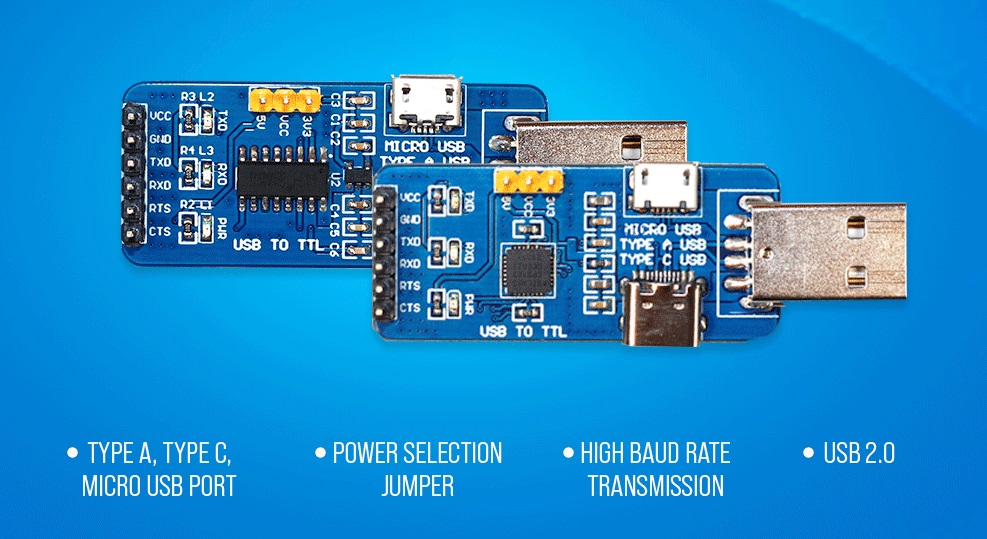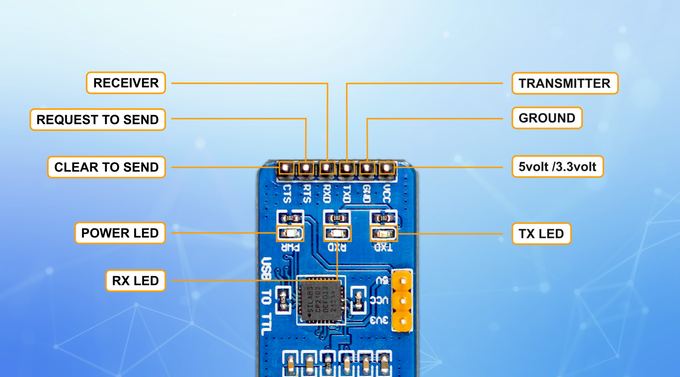This is next generation CP2102 USB/TTL Board with Additional USB type C & micro USB port which are not present in other similar Converters. This is a great little tool for embedded systems that require a serial connection to a computer. The board can simply attach to a USB, Type C & micro USB and Supports Win7/8/8.1/10/11, Mac, Linux, Android.
The CP2102 doesn’t require any external oscillator, it has an on-board voltage regulator, and it even uses a re-programmable internal EEPROM for the device description. The full hardware UART has flow control for baud rates from 300bps to 921600bps. This breakout also allows you to connect the TX/RX pins of your favorite microcontroller or serial application to the RX/TX pins of the breakout, creating a simple serial cable replacement.
“CP2102 chip from SiLabs is a single chip USB to UART Bridge IC. It requires minimal external components. CP2102 can be used to migrate legacy serial port based devices to USB”.
The CP2102 USB to UART Bridge provides a complete plug and play interface solution that includes royalty-free drivers. This USB 2.0 compliant device includes 0 digital I/O pins and is available in a 5x5 mm QFN28 package.
The USB to TTL is a great tool for embedded systems that require a serial connection to a computer. A USB to UART converter is an integrated circuit used to send or receive serial data from a USB port into serial data that can be received or sent by a UART interface. TTL stands for Transistor-Transistor Logic, a serial communication commonly found in UART (universally asynchronous receiver/transmitter) transmission method, a method seen in most microcontrollers these days.
This module break out the most common RXD/TXD/RTS/CTS/VCC/GND pins, the board also breaks out almost all the other pins. The signal pins are 5V tolerant - they should work with both 3.3V and 5V
The board also features RX, TX and Power LEDs to help you debug issues; they will light up when data is transferred.
- Adopts CP2102 chip also available in CH340 chip, it supports higher data rate and more serial port IO levels (5V / 3.3V)
- Supports Win7/8/8.1/10/11, Mac, Linux, Android...
- Onboard 3.3V and 5V TTL level switch pins for selecting TTL communication level
- Support 3.3V/5V output (the module is powered by USB, and the onboard jumper should be shorted to 3.3V or 5V accordingly)
USB TTL is developed with the advanced CP2102 and CH340 chipsets, which are 2.0 compliant and come with standard USB type A male, Type C, Micro USB, and TTL 6pin connectors. 3.3V, VCC, RTS, TXD, RXD, GND, CTS, and 5V are all represented by six pins.
USB to TTL Applications
- Programming of Arduino Pro Mini with Automatic RESET through DTR pin
- Programming of Microcontrollers that can be programmed using serial boot loaders at 3.3V or 5.0V logic levels
- Burn write STC MCU,NXP MCU, renesas MCU,NEC MCU
- Data exchange between microcontroller and Desktop or Laptop Computers
- Connection with GPS Devices
- Connection with various external Phones, or modems, GSM Modules
- All other applications requiring USB/Serial/TTL interface.
- Router, HDD, ADSL, broad band modem firmware upgrade
- Cellphone,XBOX360,GPS serial communication, vehicle inspection and test, dvd flash and so on
- Simple UART communication, commonly used UART debugging tools in supper terminal
- USB signal transferred to TTL signal, may be used by electronic enthusiasts
- Two data transmission indicator can monitor data transfer status in real time
- 3.3V and 5V power supply interface, easy for the DDWRT of different voltage system that need power.
FAQ (Frequently Asked Questions)
What is TTL UART?
TTL stands for Transistor-Transistor Logic, a serial communication commonly found in UART (universally asynchronous receiver/transmitter) transmission method, a method seen in most microcontrollers these days.
What does a USB to TTL converter do?
The AN-USB-TTL module is a cost-effective way to convert TTL signal a USB interface. When connected to a PC USB port the AN-USB-TTL module is automatically detected and is installed as a native COM port which is compatible with any existing serial communication application.
What is difference between TTL and USB?
Note that the supply of USB is 5 V, the data signals use a lower voltage. The "TTL" on an Arduino board means that the signals are 5 V. There is no TTL logic on an Arduino board at all. The ATMega chip on the Arduino can work at 3.3 V to 5.5 V so that includes TTL level signals.
What is USB to UART?
USB-to-UART Bridge
A USB to UART converter is an integrated circuit used to send or receive serial data from a USB port into serial data that can be received or sent by a UART interface.
What is the difference between UART and USB?
There is no difference; they are actually the very same port.
What does TTL mean in electronics?
Transistor-transistor logic
Transistor-transistor logic (TTL) is a digital logic design in which bipolar transistor s act on direct-current pulses. Many TTL logic gate s are typically fabricated onto a single integrated circuit (IC). TTL ICs usually have four-digit numbers beginning with 74 or 54.
Is UART faster than USB?
Usually the UART speed is up to about 1Mbps, but USB 2.0 is again asynchronous, but the specs said it can transfer up to 480Mbps
Official Product Page - USB to TTL : Complete Plug and Play interface Solution



